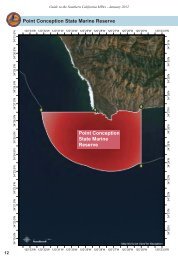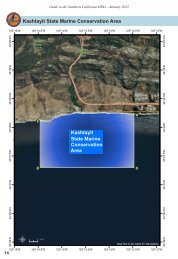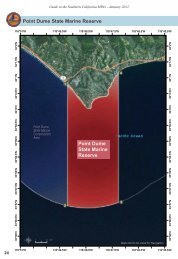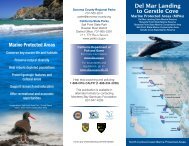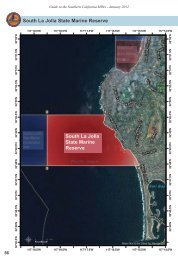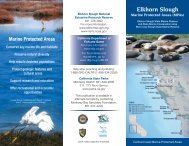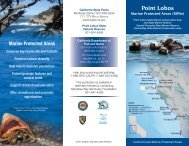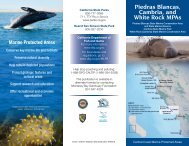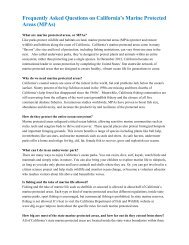Montara and Pillar Point
Montara and Pillar Point - California MPA Educational Resources
Montara and Pillar Point - California MPA Educational Resources
Create successful ePaper yourself
Turn your PDF publications into a flip-book with our unique Google optimized e-Paper software.
San Mateo County Parks<br />
Fitzgerald Marine Reserve<br />
650-728-3584<br />
California State Parks<br />
<strong>Montara</strong> State Beach<br />
Sector Office: 650-726-8819<br />
711, TTY Relay Service<br />
www.parks.ca.gov<br />
<strong>Montara</strong> <strong>and</strong><br />
<strong>Pillar</strong> <strong>Point</strong><br />
Marine Protected Areas (MPAs)<br />
<strong>Montara</strong> State Marine Reserve<br />
<strong>Pillar</strong> <strong>Point</strong> State Marine Conservation Area<br />
Marine Protected Areas<br />
Conserve key marine life <strong>and</strong> habitats<br />
Preserve natural diversity<br />
Help rebuild depleted populations<br />
Protect geologic features <strong>and</strong><br />
cultural areas<br />
Support research <strong>and</strong> education<br />
Offer recreational <strong>and</strong> economic<br />
opportunities<br />
California Department of<br />
Fish <strong>and</strong> Game<br />
For more information:<br />
www.dfg.ca.gov<br />
For boundaries <strong>and</strong><br />
regulations, go to:<br />
www.dfg.ca.gov/MLPA<br />
Help stop poaching <strong>and</strong> polluting:<br />
1-888-DFG-CALTIP (1-888-334-2258)<br />
This publication is available in<br />
alternate formats by contacting<br />
Monterey Bay Sanctuary Foundation:<br />
831-647-4209<br />
Image above: <strong>Montara</strong> State Beach (Sieboldianus)<br />
below: black oystercatcher (Ron Wolf)<br />
Cover: humpback whale fluke<br />
North Central Coast Marine Protected Areas
From tidepools to the expansive Pacific Ocean<br />
California Is Making a Difference<br />
by creating a statewide network of marine<br />
protected areas (MPAs). Marine protected<br />
areas are underwater places designed<br />
to protect key habitats <strong>and</strong> species by<br />
prohibiting or restricting the take of marine<br />
life. Just as the nation’s parks, forests <strong>and</strong><br />
wilderness areas protect special places<br />
on l<strong>and</strong>, California’s MPAs protect unique<br />
areas in the ocean <strong>and</strong> estuaries. The<br />
California MPA network includes the many<br />
different types of habitats found along our<br />
coast, from sheltered estuaries to rocky<br />
intertidal areas <strong>and</strong> lush kelp forests to<br />
steep underwater canyons.<br />
Image above left: striped shore crab (Jerry Kirkhart)<br />
above right: sea lemon (Ron Wolf)<br />
One of the most biodiverse regions of<br />
the California coast, the <strong>Montara</strong> <strong>and</strong><br />
<strong>Pillar</strong> <strong>Point</strong> MPAs are home to more than<br />
300 species including invertebrates, fish,<br />
seabirds <strong>and</strong> marine mammals. MPAs here<br />
boast some of the most prized tidepools<br />
in northern California while lush offshore<br />
kelp beds offer refuge for fish species. In<br />
recognition of the biodiversity found here,<br />
the state of California has designated them<br />
as Marine Protected Areas.<br />
Amazing Diversity of Life<br />
• Organisms seen at low tide may include<br />
chitons, snails, anemones, sea stars,<br />
crabs, nudibranchs, abalone, sea<br />
urchins, shrimp, sculpin <strong>and</strong> limpets.<br />
• This stretch of coast provides numerous<br />
haul-out sites for harbor seals <strong>and</strong> sea<br />
lions, <strong>and</strong> both MPAs are breeding areas<br />
for harbor seals.<br />
• Forty-six species of colorful nudibranchs<br />
have been found here!<br />
• An extraordinary diversity of birds<br />
benefit from the abundance of food <strong>and</strong><br />
protected habitat here including terns,<br />
egrets, great blue herons, cormorants,<br />
black oystercatchers <strong>and</strong> gulls.<br />
Nature’s Laboratory<br />
Twenty-five species of marine plants <strong>and</strong><br />
animals, new to science were discovered<br />
at Moss Beach in the <strong>Montara</strong> SMR.<br />
These MPAs are also home to several<br />
endemic species that are only found here!<br />
Inside these MPAs, crucial questions are<br />
being addressed to help underst<strong>and</strong> how<br />
to preserve these precious resources.<br />
Outdoor Classroom<br />
Explorers of all ages marvel at the<br />
diversity of life found here <strong>and</strong> learn about<br />
protecting our ocean. Every year trained<br />
naturalists from the Friends of Fitzgerald<br />
Marine Reserve lead groups of students<br />
<strong>and</strong> the public through this area diverse<br />
habitats, creating a new generation of<br />
ocean stewards.<br />
tidepool (Tom Niesen)<br />
kayaking (Claire Fackler) copper rockfish (Chad King) snowy egret (Danielle Brown)<br />
research (Amy Dean) abalone (Sarah Lenz)
California Marine Protected Areas<br />
The California statewide MPA network includes<br />
four different designation that vary in their<br />
purpose <strong>and</strong> level of protection, ranging from<br />
limited to no take. The MPA designations are:<br />
State Marine Reserves: No damage or take of living, geologic, or cultural marine resources is allowed.<br />
State Marine Parks: No commercial take of resources is allowed, but some recreational take may be allowed (restrictions vary).<br />
State Marine Conservation Areas: Some recreational <strong>and</strong>/or commercial take of marine resources may be allowed (restrictions vary).<br />
State Marine Recreational Management Areas: Restricts the take of living marine resources while allowing for waterfowl hunting to<br />
occur (restrictions vary).<br />
<strong>Montara</strong> <strong>and</strong> <strong>Pillar</strong> <strong>Point</strong> Marine Protected Areas<br />
blue-b<strong>and</strong>ed hermit crab (Jerry Kirkhart)<br />
<strong>Montara</strong> <strong>and</strong> <strong>Pillar</strong> <strong>Point</strong> MPAs<br />
MPA<br />
<strong>Montara</strong><br />
SMR<br />
<strong>Pillar</strong><br />
<strong>Point</strong><br />
SMCA<br />
Allowed Uses<br />
Take of all living marine<br />
resources is prohibited.<br />
Take of all living marine<br />
resources is prohibited<br />
except:<br />
1. Recreational take of<br />
pelagic finfish by trolling,<br />
Dungeness crab by trap<br />
<strong>and</strong> market squid by<br />
h<strong>and</strong>-held dip net are<br />
allowed.<br />
2. Commercial take of<br />
pelagic finfish with troll<br />
fishing gear or seine,<br />
Dungeness crab by<br />
trap <strong>and</strong> market squid<br />
by round haul net are<br />
allowed.<br />
Regulations<br />
This document does not replace<br />
the official regulatory language<br />
found in California Code of<br />
Regulations, Title 14, Section 632.<br />
• A fishing license is required for<br />
any fishing.<br />
• All existing take regulations still<br />
apply in addition to the ones<br />
listed above.<br />
• Unless otherwise stated, all<br />
non-consumptive recreational<br />
activities are allowed.




